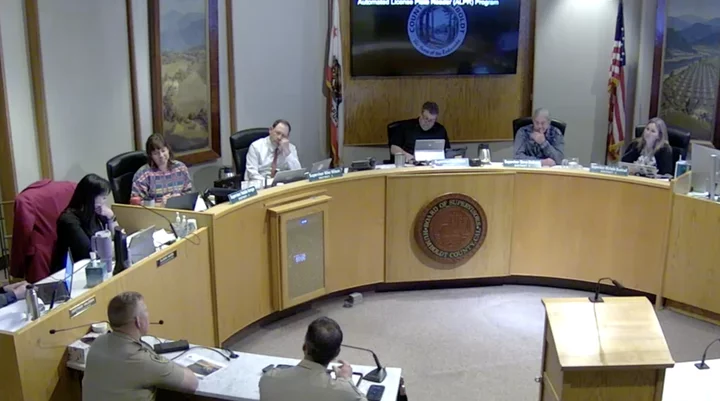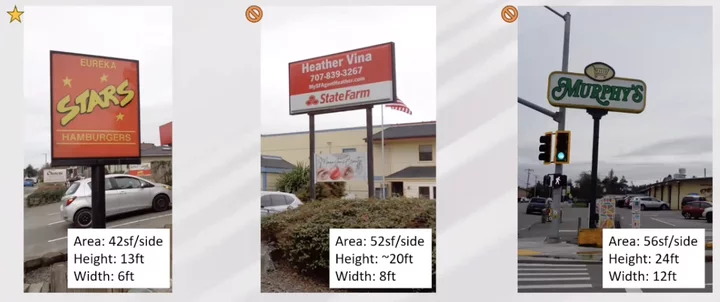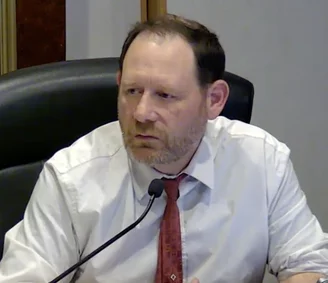Screenshot of Tuesday’s Humboldt County Board of Supervisors meeting. | Screenshot.
###
After nearly three hours of extensive deliberation, the Humboldt County Board of Supervisors on Tuesday voted to approve new rules for signs and billboards located in unincorporated areas of the county. The two ordinances – one for inland and one for coastal regions – were approved in a 3-2 vote, with Supervisors Rex Bohn and Michelle Bushnell dissenting.
The county’s existing sign regulations “are brief and not well-defined,” according to the staff report. The new rules set standards (size, height, design, location, etc.) for various types of on- and off-premise signs and billboards to “protect aesthetic values along scenic highways [and] coastal areas,” preserve environmentally sensitive habitat areas and ensure compatibility with the county’s General Plan and the Caltrans Outdoor Advertising Act.
Humboldt County Planner Jacob Dunn gave some examples of existing signs that would and would not be acceptable under the new rules. For example, the freestanding sign in front of the Eureka Stars Hamburgers on Harrison Avenue would pass muster, but the Murphy’s Market sign at the corner of Fern and Walnut Streets in Cutten would not. “That one would be too tall for the proposed regulations,” he said.
The Stars Hamburgers sign is OK under the new ordinance. The other two are too tall, according to staff. | Screenshot.
Dunn added that staff had added multiple sections to the ordinance “to create allowances for specified sign types that may not be as impactful.” The ordinance also “provides pathways for those seeking exceptions to the set performance standards with discretionary review,” he said.
The sign ordinance imposes new rules for off-premise billboards “to balance the direction of the General Plan, which intends to limit the duration of new and existing billboards while protecting sensitive environments,” the staff report states. The ordinance creates a permitting pathway for damaged billboards to be re-stabilized as long as they’re in locations where sensitive environments won’t be harmed.
During the public comment portion of the meeting, Eureka-based Allpoints Signs owner Geoff Wills claimed the proposed ordinance is “not consistent” with the county’s General Plan, adding that it infringes on the livelihood of business owners without just compensation.
“In 2017, I purchased Allpoints [Signs] for $1,650,000,” he said. “I made this investment knowing my business and private property would be protected via eminent domain law because that’s what the General Plan outlined it would do. If [this ordinance] is not amended, my company … will instantly be stripped of around $2 million in value … .”
Wills added that he is “one rainstorm away from being out of business,” implying that if one of his billboards were to blow over it could not be replaced and he would not be able to recoup the financial losses.
Local business owner Jeannie Fulton echoed some of Wills’ concerns, adding that small business owners are still struggling with the effects of the COVID-19 pandemic and the downturn in the economy. Having to retrofit and resize signage would be yet another “big expense,” she said. “I’m really hopeful that this ordinance will not pass.”
Following public comment, Bohn asked if the county would have to deploy “sign policeman” to enforce the new rules or if it would be a complaint-driven process.
“State law requires that we do one of two things,” Planning and Building Director John Ford explained. “We either … [take] an inventory of all signs and identity whether or not they’re legal or illegal and then those signs can have an enforcement process. Or you can find that all signs are legal non-conforming and basically at that point, all signs that exist, exist. That is what we’ve written into the resolution.”
Ford emphasized that on-premise signs that are already permitted can remain standing, and signs classified as “legal non-conforming” can be repaired or even replaced if damaged.
“That’s for all the other signs, other than billboards,” Ford continued. “We’re not in any way requiring existing signage to be redone or taking away entitlements from people who have existing signs. We want to be really clear on that.”
Bushnell asked what would happen if an un-permitted sign were to fall over during a storm. “They would, of course, need to come in and get their permit, but then would it be allowed to be reconstructed [as] the original [sign]?”
“That is what we are proposing, yes,” Ford said.
At one point in the discussion, Bohn said he was “probably going to vote against this whole thing” due to the potential impacts to local business owners. “I think in this day and age, everybody is just hanging on for business,” he said. “I know people hate billboards … but I haven’t had any[one from] the business community come out and tell me they hate [billboards].”
The board embarked on a long discussion, initiated by Supervisor Mike Wilson, about some of the rules surrounding illuminated and digital signs in unincorporated areas and whether there should be additional constraints on the brightness of certain signs.
Under the proposed ordinance, illuminated signs located in residential areas must be externally illuminated and located at least 50 feet away from any residence. Illuminated signs in non-residential areas can be internally or externally illuminated, though all signs “must be steady, stationary and static in color” to avoid safety hazards for motorists and pedestrians.
Digital and animated signs that “appear to rotate, flash, blink, move, change color, emit sound, or change intensity” are prohibited under the proposed rules, excluding “approved fuel price signs, standard barber poles, time and temperature signs that are located in commercial and industrial zones.” Electronic message boards and “large television or projector screens” are also prohibited, “except when placed on such property by the public agency having jurisdiction or expressly authorized by such public agency.”
Supervisor Natalie Arroyo talked a bit about her experience working on the City of Eureka’s sign ordinance during her time on the city council, saying it was “emerging as an issue and the community was clamoring for us to do something about it.” She noted that Eureka’s ordinance isn’t necessarily “a representation of what an ideal lighting situation would look like according to DarkSky standards.”
Supervisor Steve Madrone, who was silent for much of the discussion, generally spoke in favor of fewer billboards and illuminated signs across the county. “I can remember a time in the ‘70s and ‘80s, maybe even into the ‘90s when there were another 20 or more billboards along Humboldt Bay … and I have to say I really like where we’re at now compared to then,” he said. “It’s a major improvement.”
After about two and a half hours of discussion, Wilson made a motion to approve the ordinance with a few small modifications, including the following:
- Between sunset and sunrise, luminance is limited to 100 candelas per square meter. Each sign must either be designed to achieve this standard or have a light-sensing device that will automatically adjust the brightness of the display as the natural ambient light conditions change.
- Exposed bulbs are only allowed under a Creative Sign Permit.
- Signs must be maintained using the materials and dimensions found on the existing sign.
- The stated objective of the ordinance is to implement General Plan provisions to regulate billboards in accordance with the Outdoor Advertising Act.
After a bit of additional discussion, the motion was approved in a 3-2 vote, with Bohn and Bushnell dissenting. The ordinance can be viewed at this link.
###
Sheriff William Honsal and Undersheriff Justin Braud. | Screenshot.
License Plate Reader Technology for Law Enforcement
The board also received a report on the county’s new Automated License Plate Reader (ALPR) program from Undersheriff Justin Braud and Sheriff William Honsal.
The ALPR system, which is still being implemented, consists of cameras mounted to street poles or other fixed positions along a roadway that automatically take pictures of vehicle license plates, which are then translated into letters and numbers. The technology, provided by Flock Safety, can be used to find stolen vehicles and/or vehicles associated with missing individuals. ALPR does not use facial recognition technology and the data is deleted after 30 days.
“I believe that this technology is the industry standard – I believe this is the future,” Braud said. “It’s a force multiplier in a time of budgets that are [being] restrained and constrained, and this type of technology is going to do nothing but improve our ability to serve the constituents of this county and also do it in a way that respects their privacy and their rights.”
Sheriff Honsal noted that the system will become more effective if and when other municipalities sign up. Fortuna Police Chief Casey Day spoke in favor of the program, noting that it will improve law enforcement’s ability to “solve crime” and “serve the residents and the businesses within our region.”
The Board of Supervisors asked for a few particulars about the program but largely spoke in favor of its implementation. The board didn’t take any action on the item but agreed to accept the report.
The sheriff’s office policy can be read in full here.
###
Other notable bits from Tuesday’s meeting:
- The board invited representatives of Pacific Gas & Electric Co. and the Redwood Coast Energy Authority to talk about some of the rate-payer assistance programs available to local residents. Many income-eligible customers can receive financial assistance through PG&E through its California Alternate Rates for Energy (CARE) program, which provides a monthly discount of 20 percent or more on gas and electricity. A list of PG&E’s financial aid programs can be found here. A list of RCEA’s services can be found here.
- The board also declared April Child Abuse Prevention Month and received an annual report from the Child Abuse Prevention Coordinating Council.




CLICK TO MANAGE